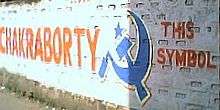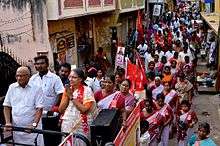Communism in India
Communism in India has existed as a political movement since at least as early as the 1920s. In its early years, the ideology was harshly suppressed through legal prohibitions and criminal prosecutions. Eventually, the movement became ensconced in national party politics, sprouting several political offshoots.
.jpg)
History
Following the Russian Revolution, Bipin Chandra Pal and Bal Gangadhar Tilak were amongst the prominent Indians who expressed their admiration of Lenin and the new rulers in Russia. Abdul Sattar Khairi and Abdul Zabbar Khairi went to Moscow, immediately on hearing about the revolution. In Moscow, they met Lenin and conveyed their greetings to him. The Russian Revolution also affected émigré Indian revolutionaries, such as the Ghadar Party in North America.[1] The Khilafat movement contributed to the emergence of early Indian communism. Many Indian Muslims left India to join the defence of the Caliphate. Several of them became communists whilst visiting Soviet territory. Some Hindus also joined the Muslim muhajirs in the travels to the Soviet areas.[2] The colonial authorities were clearly disturbed by the growing influence of Bolshevik sympathies in India. A first counter-move was the issuing of a fatwa, urging Muslims to reject communism. The Home Department established a special branch to monitor the communist influence. Customs were ordered to check the imports of Marxist literature to India. A great number of anti-communist propaganda publications were published.[3]
The First World War was accompanied with a rapid increase of industries in India, resulting in a growth of an industrial proletariat. At the same time prices of essential commodities increased. These were factors that contributed to the buildup of the Indian trade union movement. Unions were formed in the urban centres across India, and strikes were organised. In 1920, the All India Trade Union Congress was founded.[4] S. A. Dange of Bombay published a pamphlet in 1921 titled Gandhi Vs. Lenin, a comparative study of the approaches of both the leaders with Lenin coming out as better of the two. Together with Ranchoddas Bhavan Lotvala, a local mill-owner, a library of Marxist Literature was set up and publishing of translations of Marxist classics began.[5] In 1922, with Lotvala's help, Dange launched the English weekly, Socialist, the first Indian Marxist journal.[6]
The 1924 second congress of the Communist International insisted that a united front should be formed between the proletariat, peasantry and national bourgeoisie in colonised countries. Among the twenty-one conditions drafted by Lenin ahead of the congress was the 11th thesis, which stipulated that all communist parties must support the bourgeois-democratic liberation movements in the colonies. Some of the delegates opposed the idea of alliance with the bourgeoisie, and preferred support to communist movements of these countries instead. Their criticism was shared by the Indian revolutionary M.N. Roy, who attended as a delegate of the Communist Party of Mexico. The congress removed the term 'bourgeois-democratic' in what became the 8th condition.[7]
During the 1920s and the early 1930s the Communist Party of India (CPI) existed but was badly organised, and in practice there were several communist groups working with limited national coordination. The British colonial authorities had banned all communist activity, which made the task of building a united party very difficult. The CPI was founded in Tashkent on 17 October 1920, soon after the Second Congress of the Communist International. The founding members of the party were M.N. Roy, Evelina Trench Roy (Roy’s wife), Abani Mukherji, Rosa Fitingof (Abani’s wife), Mohammad Ali (Ahmed Hasan), Mohammad Shafiq Siddiqui and M.P.B.T. Acharya.[8][9] The CPI began efforts to build a party organisation inside India. Roy made contacts with Anushilan and Jugantar groups in Bengal. Small communist groups were formed in Bengal (led by Muzaffar Ahmed), Bombay (led by S.A. Dange), Madras (led by Singaravelu Chettiar), United Provinces (led by Shaukat Usmani) and Punjab (led by Ghulam Hussain). However, only Usmani became a CPI party member.[10]
Between 1921 and 1924 there were three conspiracy trials against the communist movement; First Peshawar Conspiracy Case, Meerut Conspiracy Case and the Kanpur Bolshevik Conspiracy Case. In the first three cases, Russian-trained muhajir communists were put on trial. However, the Cawnpore trial had more political impact. On 17 March 1924, Shripad Amrit Dange, M.N. Roy, Muzaffar Ahmed, Nalini Gupta, Shaukat Usmani, Singaravelu Chettiar, Ghulam Hussain and R.C. Sharma were charged, in Cawnpore (now spelt Kanpur) Bolshevik Conspiracy case. The specific pip charge was that they as communists were seeking "to deprive the King Emperor of his sovereignty of British-occupied India, by complete separation of India from imperialistic Britain by a violent revolution." Pages of newspapers daily splashed sensational communist plans and people for the first time learned, on such a large scale, about communism and its doctrines and the aims of the Communist International in India.[11]
On 1 May 1923 the Labour Kisan Party of Hindustan was founded in Madras, by Singaravelu Chettiar. The LKPH organised the first May Day celebration in India, and this was also the first time the red flag was used in India.[12][13][14]
On 25 December 1925, a communist conference was organised in Kanpur. Colonial authorities estimated that 500 persons took part in the conference. The conference was convened by a man called Satyabhakta, of whom little is known. Satyabhakta is said to have argued for a ‘national communism’ and against subordination under Comintern. Being outvoted by the other delegates, Satyabhakta left both the conference venue in protest.[15] The conference adopted the name ‘Communist Party of India’. Groups such as LKPH dissolved into the unified CPI.[16] The émigré CPI, which probably had little organic character anyway, was effectively substituted by the organisation now operating inside India.
Current status

As of 2019, the Communist Party of India (Marxist) (abbreviated CPI(M)) is the largest communist party in India. The party emerged from a split from the Communist Party of India in 1964. The CPI(M) was formed at the Seventh Congress of the Communist Party of India held in Kolkata (formerly Calcutta) from 31 October to 7 November 1964. As of 2018, CPI(M) is leading the state government in Kerala and having elected members in 8 state legislative assemblies including Kerala, West Bengal, Tripura, Himachal Pradesh, Maharashtra, Odisha, Jammu & Kashmir, and Rajasthan.[17] It also leads the West Bengal Left Front. As of 2016, CPI(M) claimed to have 1,048,678 members.[18] It is one of the eight National Parties of india.[19] The highest body of the party is the Politburo. There are a large number of smaller Marxist parties, including the Communist Party of India (Marxist-Leninist), Marxist Communist Party of India, Marxist Coordination Committee in Jharkhand, Forward Bloc in Bengal, Janathipathiya Samrakshana Samithy, Communist Marxist Party and BTR-EMS-AKG Janakeeya Vedi in Kerala, Mazdoor Mukti (Workers' Emancipation) and Party of Democratic Socialism in West Bengal, Janganotantrik Morcha in Tripura, the Ram Pasla group in Punjab, and the Orissa Communist Party in Orissa.

The Communist Party of India (Maoist) is a Maoist[20][21] communist party in India which aims to overthrow the government of India through people's war. It was founded on 21 September 2004, through the merger of the Communist Party of India (Marxist–Leninist) People's War (People's War Group), and the Maoist Communist Centre of India (MCCI). The merger was announced on 14 October the same year. In the merger a provisional central committee was constituted, with the erstwhile People's War Group leader Muppala Lakshmana Rao, alias "Ganapathi", as general secretary.[22] Further, on May Day 2014, the Communist Party of India (Marxist–Leninist) Naxalbari merged into the CPI (Maoist).[23] The CPI (Maoist) are often referred to as the intellectuals in reference to the Naxalbari insurrection conducted by radical Maoists in West Bengal in 1967.[24]:101–102 CPI(Maoist) is designated as a terrorist organisation in India under Unlawful Activities (Prevention) Act.[25][26][27][28]
See also
References
- M.V.S. Koteswara Rao. Communist Parties and United Front – Experience in Kerala and West Bengal. Hyderabad: Prajasakti Book House, 2003. p. 82, 103
- M.V.S. Koteswara Rao. Communist Parties and United Front – Experience in Kerala and West Bengal. Hyderabad: Prajasakti Book House, 2003. p. 83
- M.V.S. Koteswara Rao. Communist Parties and United Front – Experience in Kerala and West Bengal. Hyderabad: Prajasakti Book House, 2003. p. 82-83
- M.V.S. Koteswara Rao. Communist Parties and United Front – Experience in Kerala and West Bengal. Hyderabad: Prajasakti Book House, 2003. p. 83-84
- Riepe, Dale. Marxism in India in Parsons, Howard Lee and Sommerville, John (ed.) Marxism, Revolution and Peace. Amsterdam: John Benjamins Publishing Company, 1977. p. 41.
- Sen, Mohit. The Dange Centenary in Banerjee, Gopal (ed.) S.A. Dange – A Fruitful Life. Kolkata: Progressive Publishers, 2002. p. 43.
- M.V.S. Koteswara Rao. Communist Parties and United Front – Experience in Kerala and West Bengal. Hyderabad: Prajasakti Book House, 2003. p. 48, 84–85
- M.V.S. Koteswara Rao. Communist Parties and United Front – Experience in Kerala and West Bengal. Hyderabad: Prajasakti Book House, 2003. p. 88-89
- Ganguly, Basudev. S.A. Dange – A Living Presence at the Centenary Year in Banerjee, Gopal (ed.) S.A. Dange – A Fruitful Life. Kolkata: Progressive Publishers, 2002. p. 63.
- M.V.S. Koteswara Rao. Communist Parties and United Front – Experience in Kerala and West Bengal. Hyderabad: Prajasakti Book House, 2003. p. 89
- Ralhan, O.P. (ed.) Encyclopedia of Political Parties New Delhi: Anmol Publications p. 336, Rao. p. 89-91.
- :: Singaravelar – Achievements Archived 21 April 2011 at the Wayback Machine
- M.V.S. Koteswara Rao. Communist Parties and United Front – Experience in Kerala and West Bengal. Hyderabad: Prajasakti Book House, 2003. p. 110
- Report of May Day Celebrations 1923, and Formation of a New Party (The Hindu quoted in Murugesan, K., Subramanyam, C. S. Singaravelu, First Communist in South India. New Delhi: People's Publishing House, 1975. p.169
- Satyabhakta then formed a party called National Communist Party, which lasted until 1927.
- M.V.S. Koteswara Rao. Communist Parties and United Front – Experience in Kerala and West Bengal. Hyderabad: Prajasakti Book House, 2003. p. 92-93
- "RAJASTHAN ELECTION RESULTS 2018". 28 November 2014. Retrieved 12 December 2018.
- "About Communism Party of India (Marxist)". Archived from the original on 28 November 2014. Retrieved 14 November 2014.
- "Recognized Political Parties:ECI".
- Deepak Kapoor, AVSM PVSM, SM VSM Chief of Army Staff (India) (2009). South Asia Defence And Strategic Year Book. Pentagon Press. pp. 62–63. ISBN 8182743990.CS1 maint: uses authors parameter (link)
- "CPI (Maoist) commander Hidma promoted to Central Committee". thehindu.com. Retrieved April 27, 2019.
- "Communist Party of India-Maoist (CPI-Maoist)". South Asia Terrorism Portal. Institute for Conflict Management. Retrieved 19 January 2010.
- "CPI(ML) Naxalbari, CPI(Maoist) merge". The Hindu. The Hindu. May 1, 2014. Retrieved May 3, 2014.
- Pandita, Rahul (2011). Hello, Bastar : The Untold Story of India's Maoist Movement. Chennai: Westland (Tranquebar Press). ISBN 978-93-80658-34-6. OCLC 754482226.
- "Maoists fourth deadliest terror outfit after Taliban, IS, Boko Haram: Report".
- ""Most terrorists in India are Hindus, the ones whom we have conveniently labelled 'Maoist' instead of 'Hindu'."".
- http://scroll.in/article/718458/most-extremists-in-india-are-not-muslim-they-are-hindu
- http://www.outlookindia.com/website/story/are-most-terrorists-in-india-muslims/293911